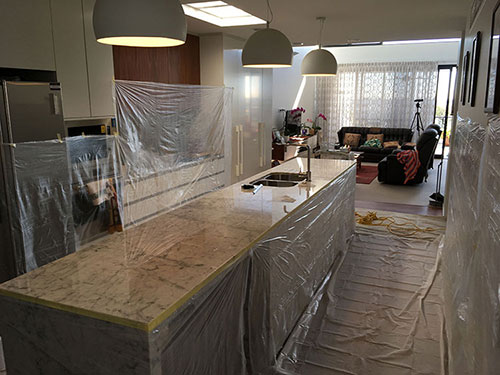Stone Care Terminology
Acid Wash
Acid wash is a treatment that is applied to the face of a stone surface to achieve a distressed finish.
Alkaline
Alkaline refers to a highly basic substance instead of acidic.
Ambient Temperature
Ambient temperature refers to the surrounding environment.
Argillite
Argillite is a weakly metamorphosed compact rock that is mainly made up of clay and shale.
Artificial Stone / Engineered Stone
Artificial stone is a manmade product that replicates the look and feel of natural stone.
Basalt
Basalt is an igneous rock of a dark colour. It’s commercially known as granite when processed as dimension stone.
Bluestone
Bluestone is a fine to medium grain, quartz-based stone.
Brushed
A subtly textured surface finish achieved by wet brushing a stone with a coarse rotary-type abrasive brush.
Calcarenite
Calcarenite is limestone composed predominantly of cemented sand-size grains of the mineral calcite.
Calcareous
Calcareous refers to substances containing or made up of calcium carbonate
Calcite
Calcite is a common mineral in rock formation. Calcite is the chief constituent of limestone and the majority of marble.
Calcite Limestone
Calcite limestone contains no more than 5% of magnesium carbonate
Calcite Streaks
Calcite streaks are white or milky streaks that occur in some stone.
Cladding
Cladding is an exterior veneer that can be made of many materials including stone. Cladding is for appearance purposes only and holds no load-bearing capabilities.
Clast
This is an individual grain or constituent of sedimentary rock.
Cobblestone
Cobblestone is a dimension stone commonly used for paving.
Crack
A crack is a man-made break, split, fracture, separation visible to the human eye.
Damp Proofing
Coatings of a compound that is impervious to water. This is usually applied to the back or face of the stone.
Diamond
Diamond is a carbon-based mineral that is usually man-made. It is used as an abrasive in stone cutting and restoration equipment.
Dolomitic Limestone
Dolomitic limestone contains more than 10% but less than 80% of the mineral dolomite.
Dry Seam
A dry seam is a naturally occurring fracture in stone that may be a point of weakness.
Durability
Durability refers to a stones ability to maintain its natural properties and appearance when exposed to the elements or outside forces/substances.
Epoxy Resin
Epoxy Resin is used as an adhesive.
Exfoliation
Exfoliation is the peeling or scaling of stone surfaces caused by chemical or physical weathering.
Exposed Face
The exposed face is the side of the stone that is visible.
Face
The face is the exposed surface of stone on a structure.
Feldspar
Feldspar is a group of crystalline minerals, all silicates of aluminium with potassium, sodium, calcium, or barium. It’s an essential constituent of nearly all crystalline rocks.
Finish
The finish is the process applied to the visible side of the stone, this is most commonly honed or polished.
Flamed Finish
A flamed finish is a textured surface treatment applied by brief exposure to intense heat.
Fracture
A fracture is any break or separation of fabric within the stone as a result of mechanical stress.
Granite
Granite is a hard, crystalline, igneous rock. It’s grey to pink in colour. Its composition includes feldspar, quartz and smaller amounts of dark ferromagnesian materials.
Granular
Granular refers to stones that have a texture of particles that are visible to the naked eye.
Greenstone
Greenstone is a metamorphic rock, the colours range from medium-green, yellowish-green to black.
Grind
To grind refers to the process of removing portions of stone through an abrasive method.
Hardness
The hardness of the stone most commonly refers to a stone’s resistance to abrasion.
Honed
A honed finish is a satin-smooth finish applied to the visible surface of the stone.
Igneous
Igneous is one of the three main rock classifications and refers to any of the various volcanic rocks, solidified after the molten state.
Impregnators – Impregnatable sealer
An impregnator is an applied repellent that penetrates into the stone and sits below the finished surface.
Kaolinite
Kaolinite is a hydrous aluminium silicate mineral
Lamination
Lamination is a term used when two or more slabs of stone are adhered together, this is common in countertops applying the effect that the stone is thicker than it actually is.
Limestone
Limestone is a sedimentary rock composed primarily of calcite or dolomite.
Lippage
Lippage refers to two stone surfaces that do not meet evenly causing a lip. This occurs when one of the stone surfaces is raised above the other.
Maintenance
Cleaning and other servicing activities including sealing that happen on a regular or scheduled basis.
Marble
Marble is a metamorphic crystalline rock made primarily of crystalline grains of calcite, dolomite, or serpentine.
Metamorphic Rock
Metamorphic rock is altered in appearance, density, crystalline structure and in some cases, mineral composition, by high temperature and intense pressure.
Metamorphism
The change or alteration in a rock caused by exterior agencies, such as deep-seated heat and pressure, or intrusion of rock materials.
Microcrystalline
A stone that consists largely or wholly of crystals that are so small as to be recognizable only under magnification.
Obsidian
A glassy phase of lava.
Onyx
Onyx is commonly translucent and typically layered, cryptocrystalline calcite with colours in pastel shades.
Oolitic Limestone
Oolitic limestone is a calcite-cemented calcareous stone formed of shells and shell fragments, practically noncrystalline in character.
Patina
Patina is the change in colour or texture of the natural stone surface due to age or exposure to various elements.
Polished finish
A glossy, highly reflective surface finish.
Polishing compounds
Powders and chemicals used in addition to machine heads to achieve a polished finish.
Polishing Cream
Polishing cream is a compound that is supplied in a cream or paste consistency
Polishing Pads
Flexible disks with embedded abrasives used with handheld tools or floor machines.
Poultice
Any absorbent material used in a saturated condition with water or solvent-based fluids and applied to a stone surface for the purpose of removing embedded stains.
Quartz
Quartz is a silicon dioxide mineral that occurs in colourless and transparent or coloured hexagonal crystals or in crystalline masses.
Quartzite
Quartzite is a dense hard metamorphic quartz-based stone typically formed from sandstone.
Quartzitic Sandstone
A variety of sandstone including higher content of free silica and siliceous cement than typical quartz-based sandstones.
Refinishing
The process of in-situ finishing of existing stonework to return it to its near original appearance.
Resin
Any of a number of clear or translucent substances, either from plant origin or synthetics, used in producing lacquers, adhesives, plastics, polyesters, epoxies, silicones etc.
Resin Patching Sticks
A stone patching material supplies as a solid substance and installed in a heated condition to facilitate flowing into surface imperfections to be filled.
Restoration
The actions are taken to bring a stone surface back to its original finished state.
Ribbon
Narrow bands of rock within the quarry deposit of contrasting colour or texture due to varying mineralogical composition.
Rough Sawn
A surface finish resulting from the gang or wire sawing process
Sandblasted
A matte-textured surface finish produced by small particles (sand) striking the stone surface at high velocities
Sandstone
Sandstones are sedimentary rocks usually composed of quartz cemented with silica, iron oxide or calcium carbonate.
Sealer
A protective coating or treatment which prevents foreign liquid or matter from penetrating the stone by closing the pores in the surface.
Sealing
The process of applying a sealer.
Sedimentary
Rocks formed by deposition of particles, or “sediments” laid down in successive strata and cemented together by another agent.
Serpentine
A common hydrous magnesium silicate rock-forming mineral; generally dark green in colour with markings of white, light green, or black.
Shale
A fine-grained sedimentary stone formed by the compaction of clay, silt, or mud.
Silica
An oxide of silicon with the chemical for- Mula SiO2, found abundantly in nature as sand quartz, or other rock components,
Siliceous
A rock bearing abundant silica.
Slurry
A suspension of insoluble particles in a liquid.
Slate
A very fine-grained metamorphic rock derived from sedimentary shale rock, with excellent parallel cleavage, and entirely independent of original bedding, slate may be split easily into relatively thin slabs.
Stripping
To remove coatings that block a stone’s ability to breathe which may cause spall-ing (when the stones crack, pop, or shale).
Terrazzo
A flooring surface of marble or granite chips in a cementitious or resinous matrix, which is ground and finished after setting.
Textured Finish
Any of the rough surface finishes used in dimension stone, selected for aesthetic reasons or as friction performance for walking surfaces.
Travertine
A variety of limestone formed by chemical precipitate from hot springs. Some varieties of travertine take a polish and are known commercially as marble.
Tumbled Finish
A weathered, aging finish created when the stone is tumbled with sand, pebbles, or steel bearings.
Vein
A layer, seam, or narrow irregular body of mineral material contrasting the surrounding material in either colour, texture, or both.
Veneer
A non-structural facing of stone, interior or exterior, serving as ornamentation and a weather barrier.
Get Started & Book Now!
Brisbane's local stone restorations & repair specialist
*The information provided on this site about our processes and products used is intended for general guidance only. The methods for stone work can vary significantly depending on the specific characteristics and condition of your stone surface. Factors such as the type and composition of the stone can influence the appropriate process. Following a thorough evaluation, our team will advise you on the best approach for your stone surface.






